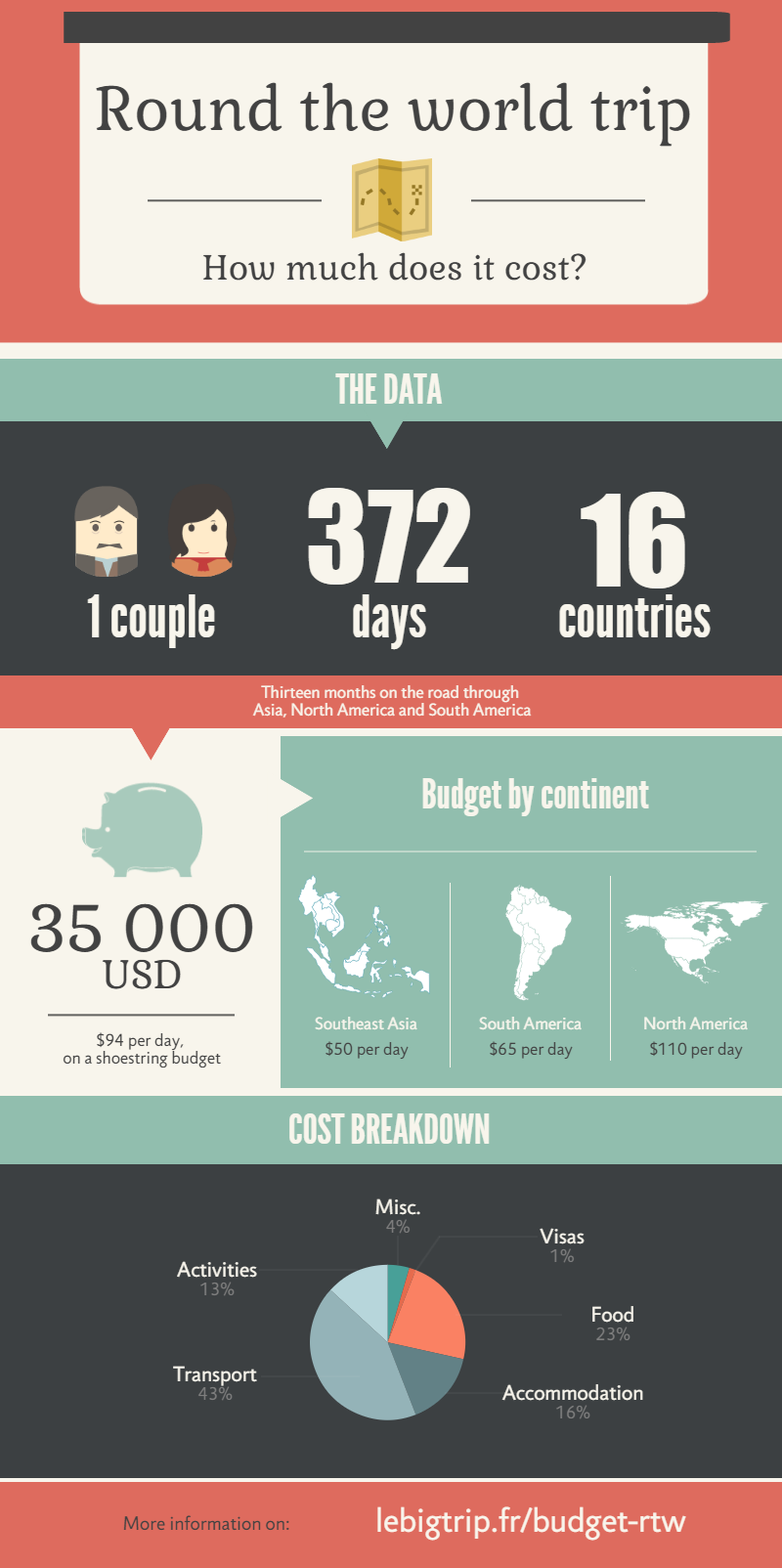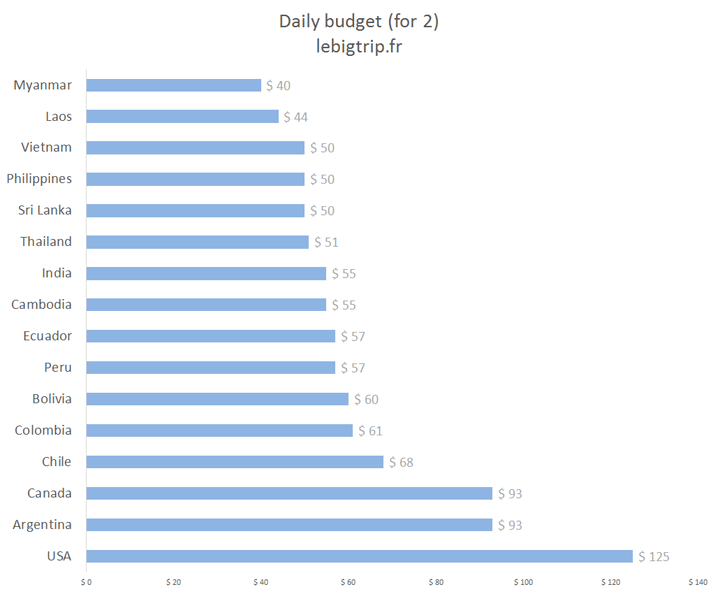![[:fr]Budget tour du monde[:en]Round the world budget[:]](https://lebigtriptravel.com/wp-content/uploads/2015/04/Budget-tour-du-monde-combien-ca-coute.png)
How much does a round the world trip cost
We often get asked, “How much a round the world trip or travelling long-term cost?”… and the answer isn’t that simple.
Many factors come into play:
– The countries visited: your budget will not be the same if you go to the United States or if you go to Vietnam.
– The comfort you’re after: are you willing to take longer flights with more stopovers and maybe leave in the middle of the night to save money?
– The type of accommodation: a basic room is ok for you (you just want a place to sleep, especially after a long day walking) or are you looking for a place to relax?
– The season: travelling in high season is much more expensive than in low season, but the weather will be less favorable.
– The type of activities you want to do …
You need to define all of these before you can start thinking about the budget.
In this post, I will first show you the actual budget of our round the world trip . Then, you will get some tips to help you define your budget, along with more information on our expenses.
NOTE: The budget on this page has been calculated for a couple
A / How much does a round the world trip cost?
Here’s a little summary of our expenses. It’s our first infographic !! (Tell us what you think)
B / Budgeting, where to start?
If you’re at the budgeting stage, I assume the list of countries you’re planning on visiting is finalised, or nearly there?
Let’s look into the daily budget for each of these countries.
Define the daily budget per country
The cost of travelling in some countries has increased dramatically in the last years (it’s the case of Myanmar). For that reason, it’s good to get an idea of the average daily budget you need for each country before you leave. Some people we met had to cut short their travel because of bad planning… and I’m sure you don’t want that. I’m not trying to freak you out here but it’s good to be prepared.
You can get a good idea of the budget needed by:
– using travel guides: lonely planet, rough guides, le routard (French guide), … They will give you an overall idea of the daily budget needed.
– searching on forums and blogs: nothing’s better than feedback from people who just came back from those countries
There is no simple solution to get that data. Some websites can give you an idea of the daily budget needed, but there are so many variables to consider that it is better to spend a little time defining the budget yourself, based on different sources.
The below graph shows our daily budget, for 2 people. It includes local transport, food, accommodation, and some side expenses (a few presents, stamps…).
Notes:
United States – In order to visit some of the National Parks: we rented a car, spent 16 nights in a tent (camping equipment rental and cost of camping included). Then, we rented a van and paid camping spots for a week.
Canada – we stayed 24 days and did not pay for housing for a couple of weeks (thanks to our friends!)
South America – We mainly slept in dorms and often cooked our meals.
We have not been to the Galapagos (wasn’t in our budget for this time).
Asia – We always headed for the cheapest options (hotels, meals, activities …).
Even if we were very careful with our budget, we did a few great activities like scuba diving, paragliding, … but we avoided the ultra expensive ones like hot air ballooning.
Don’t forget the visas
Some visas can be quite expensive. It is best to check their prices and confirm when you need to get them at the same time. Some visas must be requested in advance, others at the last minute, just before arriving in the country and the other can be obtained once you land in the country (at the airport).
It cost us $45o for 2 people with a French passport
With our passports, we were lucky not to have to pay visa in South America.
Health and travel equipment
In addition, you will need to budget for:
– travel insurance (we chose ISIC, which is not only for students – $600 per person)
– travel vaccines (the cost depends on the shots you need to get) – We spent $760 on vaccines.
– a travel medical kit (do not forget to include the anti-malarial pills, which can be expensive)
– travel equipment and clothing (chosen based on your holiday activities: hiking, beach …)
We spent $1,500 on equipment and travel clothes for 2 people.
This includes:
– our backpacks. Btw they’re amazing, I’ll speak about these in an other post.
– all the clothes we needed for the trip (except some small things we already had)
We already had a DSLR, lenses and a backpack for the camera, so these are not included in the RTW budget.
I’ll give you more detail on these in a future post.
Flights
If you haven’t freaked out yet and still intend to go on a rtw trip, it’s time for the next big task: compare flight tickets.
There are 2 options:
– Buy a round the world ticket
These tickets are offered by alliances (Star Alliance, One World, …) and some airlines (Emirates, Air New Zealand …). It is usually cheaper if you go through specialised agencies such as Voyageurs du Monde , Zip World , Connaisseurs du Voyage.
Prices vary depending on the number of continents, number of stopovers and dates you intend to fly.
Pros:
You deal with specialists, so they understand your needs and can help you define your trip.
The ticket is valid for one year.
Cons:
It has to be used within a year: that one goes into the pros and cons sections. If you are flexible, having this one year limit can be a hassle.
The number of countries is fixed and they generally can’t be changed if needed.
Some companies charge a fee in case of date change.
– Buy as you go
Everything is in the title: you manage everything and compare the prices of tickets as you go.
Pros:
100% flexible and you can buy low-cost plane tickets when needed and when the prices are advantageous. You can change your itinerary at any time.
Cons:
You need to be organised and buy flight tickets a few weeks/months in advance to get a good price. If you wait until the last moment, this option might get more expensive than a round the world ticket.
Our choice:
We didn’t go for the RTW ticket option because we didn’t need to go through Australia and New Zealand (we had already visited those countries). All options made us go through Oceania, so the tickets were too expensive for what we wanted to do.
We took 2 return tickets: one to go to Asia and one to go to South America. This allowed us to have a break back home, in France … and that was great. We were glad to be pampered by the parents for a few days. We added flight tickets as we needed.
We took the tickets below, for our round the world trip (price for 2 people):
1 – France – Thailand with a stopover:
Paris – Sri Lanka – Bangkok – Mumbai – Paris $2,160
You can go through travel agencies to compare prices of tickets with additional stopovers. We bought ours through Flight Center and flew with Royal Jordanian and Jet Airways.
2 – Thailand – Myanmar
Return ticket Bangkok – Yangon, Air Asia $400. We had to fly as the land borders were closed.
3 – Vietnam – Philippines
Hanoi – Manila, $240 one way
Manila – Busuanga (Coron Island), $85 one way
Puerto Princesa (Palawan Island) – Manilla, $60 one way
Manila – Bangkok, $145 one way
We flew with Cebu Pacific Air.
4 – France – South America
Lyon – Buenos Aires – Bogota – Paris, $2,015 with Iberia. Unusual huh ?!
Finally, we did not use our return ticket (Bogota-Paris) because we wanted to add an extra month and a half to our trip. Iberia has allowed us to change neither the date nor the destination (unless we paid more than $1,000) … In addition, the customer service is usually unreachable. I highly “recommend avoiding” this company.
5 – South America – North America
Bogota – Vegas – San Francisco – New York, $1,120 with United Airlines.
6 – Back in France, through the box Canada
Montreal – Paris, $770 with Air Transat
Total: $6,995 for 2 people.
Other expenses
Don’t forget to include anything else you would need: contact lenses, cost for dives… Do you need to buy a new camera, or binoculars to spot animals in Costa Rica or Yellowstone?
Take the time to update the list of things you need to purchase for the trip, based on what comes up.
C / Total budget for your round the world trip
By now you should have a good idea of your final budget.
What if the total is too high?
You may need to review the list of countries you want to visit. The total budget is often too high at this point. It’s absolutely normal … we all dream about seeing everything and doing everything, but we must be realistic. Here are some ways to reduce the budget:
– reduce the number of countries where you want to go (ideally remove the most expensive countries)
– stay longer in each country, transportation adds up to approximately 40% of your budget. Spend more time in one place will allow you to spend less (you see what I mean?) … and have a break!
– think couchsurfing, house sitting, woofing. It will allow you to spend less and get to know the locals.
– travel in low season, some countries are very pleasant during that time: fewer tourists, everything is cheaper and easier to negotiate.
Set a maximum
Now you’re almost done. When you have finished, set a maximum. Otherwise, it’s too tempting to enjoy a massage every day under the pretext that it is cheaper in Thailand.
Do not forget to keep some money aside for your return: to give you time to find a job, an apartment without too much stress… if this is not already managed.
D / Keep track of the daily expenses
We used an Excel file created by a little adrift to monitor our budget.
It helps you detail your previsions by category and helps you track your expenses. You can save it on your computer, if you’ll have one during your long-term travel, or save it on google drive.
Keeping your expenses up to date takes time (and discipline):
– If you have a tight budget: you will need to take that time and write down all your expenses. It will allow you to quickly see where you spend the most and so pinpoint the areas where you can save.
– Otherwise, you have 2 solutions:
– Keep track of your expenses for the first week in each country, and use that to check how much you will spend by the end of your stay in each country (add a small margin)
– Note your expenses on a daily basis: no need to split by type (accommodation, food …), only write down the total amount.
We followed our budget very closely in Asia … we were in the cheapest hotels, eating in the cheapest restaurants … Then we realised we were going to do a round the world trip once in our lives and wanted to enjoy ourselves and have great moments. So have fun, create memories and remember that the budget shouldn’t become an obsession.
This post was meant to be shorter, but there are so many things to cover. I hope it has helped you set your budget. Feel free to comment if you have any questions or just want to say hi. Do not hesitate to share this post if you found it interesting.
Bon Voyage! And don’t be a stranger 🙂







Tracey
Excellent information, and the infographics are great! Thanks for sharing.
rafika
We’re really happy you found the post helpful Tracey
Jandelle Cobbs
Hello, I wonder, how you managed with your electronics? as: plugs/ sockets/ chargers vary by country.
rafika
Hi Jandelle,
We had 2 international power adapters that we used in all the countries we visited. It worked everywhere 🙂
Ludovic FAVARETTE
Bonjour,
Merci pour votre site, je suis rentré par votre première infographie Pinterest ! Les conseils sont précieux et nous seront utiles. Merci de partager tout cela. Avez-vous croisé des familles en dortoir ? Je me pose la question car nous voyageons a 5 avec un petit gars 11 ans et deux puces de 9 et 3 ans !
Merci d’avance et je vous souhaite de nouveaux beaux voyages !
rafika
Bonjour Ludovic
Je suis contente que l’infographie t’ait plu. On a essayé de la rendre aussi facile à lire que possible tout en mettant le max d’informations 😀
On a vu des familles en dortoir pendant nos voyages (surtout en Amérique du Sud). C’est de plus en plus commun, il y a même des “family rooms” des fois! 🙂
Par contre je te conseillerais de faire des recherches avant de réserver car certains hostels, plus pour les fêtards, seront un peu moins agréables en famille.
Vous comptez partir en tour du monde?
Francois St-Pierre
Tres bon article !
Je fais actuellement aussi un tour du monde avec ma copine et j’aimerais ajouter qu’une option intéressante est de regarder pour louer des appartements lorsque c’est possible (Airbnb notamment). Ce n’est souvent pas plus cher qu’une chambre d’hôtel modique et ça permet de cuisiner un peu et sauver sur le coût des repas. Aussi, aller “faire son marché” en Amérique du Sud ou en Afrique est souvent une expérience des plus intéressante.
Une autre chose permettant de sauver un peu sur le coût est de profiter des programmes de récompense de sites comme hôtels.com qui donne, en gros, une nuitée gratuite toutes les 10 réservations…sur 300 jours de voyage c’est un mois d’hébergement gratuit !
Francois
rafika
Merci pour ton commentaire Francois.
Ce sont de très bonnes remarques. Nous avons surtout utilisé AirBnb en Amérique du Sud et Amérique du Nord.
Et les marchés en Asie et Amérique du Sud sont toujours un plaisir.
Vous êtes où en ce moment?
Bon tour du monde! 🙂
Eleonore
Bonjour,
Vous parlez dans ce tres bon article de vos sacs à dos et j’aimerai en savoir un peu plus sur la taille, le confort, l’usage …
Merci d’avance et bravo pour ce blog!
Eleonore
rafika
Bonjour Eleonore,
Nous aborderons ce sujet dans un prochain article.
En attendant, je t’envois un email avec quelques infos.
Merci de nous suivre 🙂
Mike
Salut amis voyageurs ! j’ajoute moi aussi mon petit grain de compliment et vous remercie d’avoir créé ce blog tout à fait intéressant de A à Z (dommage que l’alphabet ne soit pas assez long d’ailleurs). On voit le plaisir que vous avez à partager vos expériences de voyage et c’est un plaisir de vous lire. Suis-je le seul qui ai eu l’impression de voyager à vos côtés rien qu’à la puissance de la lecture ? j’en doute ! Je me rend compte aussi que je me suis perdu dans mes compliments à tel point que j’en ai oublié la question que je souhaitais accompagner de ces louanges méritées………… Ah ! Voilà : à travers cet article, nous avons pu comprendre que voyager représentait un coût assez ahurissant (pour ne pas dire astronomique, bien que cela reste mon point de vue de jeune étudiant) et donc un investissement plutôt important. N’ayant pas encore lu la totalité de vos articles (cela ne saurait que tarder), pouvez-vous nous dire si cela n’est pas déjà fait, comment s’est passé la partie “économie” ? Par cela j’entends; combien de temps cela vous a priss pour économiser, quels gestes/règles indispensables avez-vous adopté afin de pouvoir continuer à vivre convenablement en France tout en préparant au mieux votre budget….. etc.
Je pense, ou du moins j’espère que vous avez pu cerner ma question. Sur ce, je vous remercie d’avoir pris le temps de me lire et vous souhaite encore beaucoup de chemins à parcourir sur les routes de notre Terre adorée, que vous puissiez aussi embellir votre blog de photos et d’articles tout aussi captivant que ce que vous avez déjà pu partager jusqu’à présent. À très bientôt
rafika
Salut Mike,
Tout d’abord merci! Cela me touche vraiment que le blog te plaise autant.
Tu poses là une très bonne question.
J’étais étudiante lorsque je suis partie pour la première fois, en Australie. Afin de financer ce voyage, j’ai mis de côté 50 euros par mois, pendant plusieurs années. Ce n’était pas beaucoup, mais à cette période-là je ne pouvais pas faire plus (et pourtant je travaillais tous les étés).
Avant notre tour du monde, nous avons vécu 5 ans en Australie. On était en collocation la majeure partie de ce temps et faisions attention à nos dépenses. Notre but premier a toujours était de garder nos économies pour voyager. 🙂
C’est un sujet difficile, car chacun d’entre nous économise de manière différente. Mais le meilleur conseil que je puisse te donner est de regarder tes dépenses sur plusieurs mois et de voir ce que tu peux réduire sans non plus te priver de tout.
Vas-tu régulièrement en concerts? Sors-tu beaucoup? Peux-tu trouver un petit boulot pendant tes études ?
Planifies en avance : pour les prochains Noel/anniversaire tu peux demander à avoir de l’argent plutôt que des cadeaux, profites des soldes pour t’équiper…
Les prévisions budgétaires te permettront de te fixer un but tout en restant motivé.
Ensuite, niveau voyage, le mieux est de privilégier les continents les moins chers : si tu vas seulement en Asie, tes dépenses s’élèveront à 20/25euros par jour, en faisant attention. En restant sur un continent, tu peux aussi économiser en privilégiant les transports terrestres, moins chers que l’avion. Tu peux t’en sortir à moins de 10 000 euros pour un an en Asie.
Les prévisions budgétaires sont un élément crucial lors de la préparation d’un voyage. Cela te permet de définir le montant que tu dois économiser et définir un plan d’action afin de l’atteindre.
Si tu souhaites tout de même aller dans des pays plus cher, tu peux utiliser le couchsurfing pour dépenser moins en logement tout en faisant de belles rencontres et comprendre un peu plus la culture du pays où tu voyages. Tu peux aussi éviter les “zones” chères de ces continents (par exemple la Patagonie nous a couté plus cher en moyenne que le reste de l’Amérique du Sud)
Tu as aussi la possibilité de travailler une fois sur place et de renflouer les caisses.
J’ai parlé de plus que de notre expérience car la partie économie dépend vraiment de la situation de chacun, mais j’espère que cela réponds à ta question.
sérovi
Salut les Bigtripeurs, super intéressante votre page. Je vois que l’Argentine ça fait mal au budget! Et qu’il va falloir nous préparer à dormir en dortoirs en Amérique du Sud! Tiuss
rafika
Et oui, ça change de l’Asie, mais ça vaut le coup!! Et puis, on rencontre plein de monde sympa en dortoirs 🙂
Laurent
Salut à tous les 2 !!
J’espère que vous allez bien. Idem, je ne pensais pas l’Argentine si cher. Pour le budget total c’est ce que je me disais dans les grandes lignes.
Cette page est très sympa, je trouvais déjà le blog très bien fait (juste ce qu’il faut de publications et de belles photos). Une bonne source pour les voyages à venir. ++
Laurent (de passage au Cambodge un 31 décembre en 2012 !!)
rafika
Salut Laurent!
Ca faut plus de 2 ans déjà qu’on s’est rencontrés au Cambodge… Le temps passe vite.
Merci encore de nous suivre 🙂 On est contents que le blog te plaise 🙂
Alors, tu connais déjà t’as prochaine destination ?